It’s no secret – cats love the feel of the wind in their whiskers. They love sleeping in sun puddles and watching birds. But we can’t always take our little adventurers out for a hike, and besides, not every cat is comfortable exploring the world on a leash. That’s where catios come in.
Catios are outdoor spaces that are totally enclosed so that cats of all backgrounds and personalities can get a taste of the outdoors without any of the risks.
Why build a catio?
Maybe you live in the city, or in the countryside where predators roam. Maybe you have a timid indoor cat who would really appreciate some fresh air. Maybe your cat seems lethargic, bored or anxious.
“Since we are not comfortable with letting our cats out without a leash, we thought a catio would be a good compromise,” Jordan Hardiman, owner of two cats named Simon and Ezra, told Adventure Cats. Ezra is the adventurer of the two, but they both love their catio.
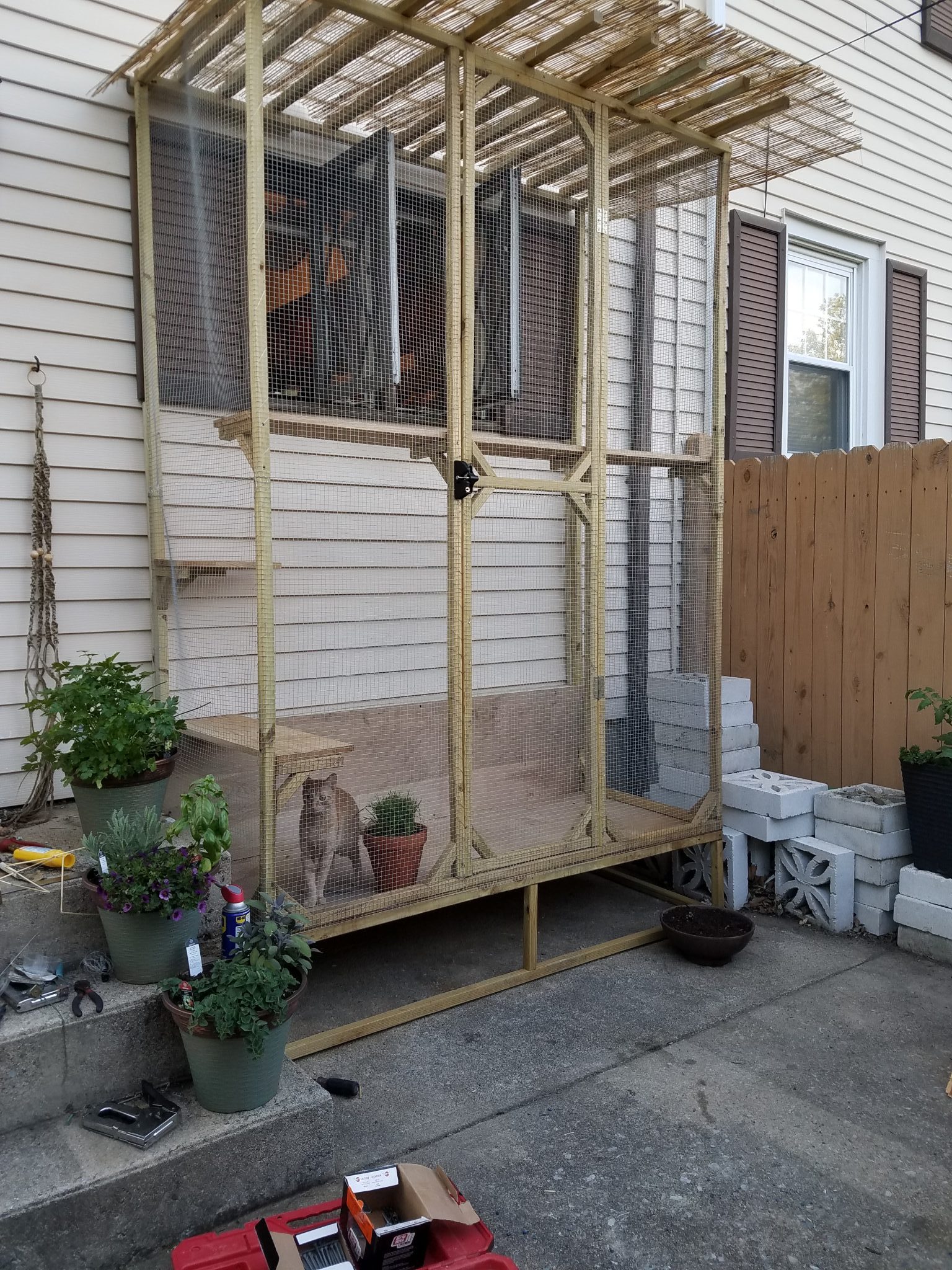
Safely enclosed, with a door, shelves and even a plant, this catio is everything these kitties need. (Photo: Jordan Hardiman)
Another reason to build a catio might be to alleviate stress and provide extra stimulation to cats who seem anxious.
“We decided to build the catio in an effort to give our Maine Coon mix, Subi, more stimulation,” said Nicole Pulfer. Pulfer and her husband thought their kitty might be experiencing separation anxiety. “We suspected the anxiety when he started pulling out clumps of his fur,” she said. “After taking him to the vet and putting him through a myriad of tests with normal results, our vet came back with only the suggestion of Subi being bored and lonely. I did a little research and Pinterest-ing and found that indoor cats do well with catios to help with stimulation.”
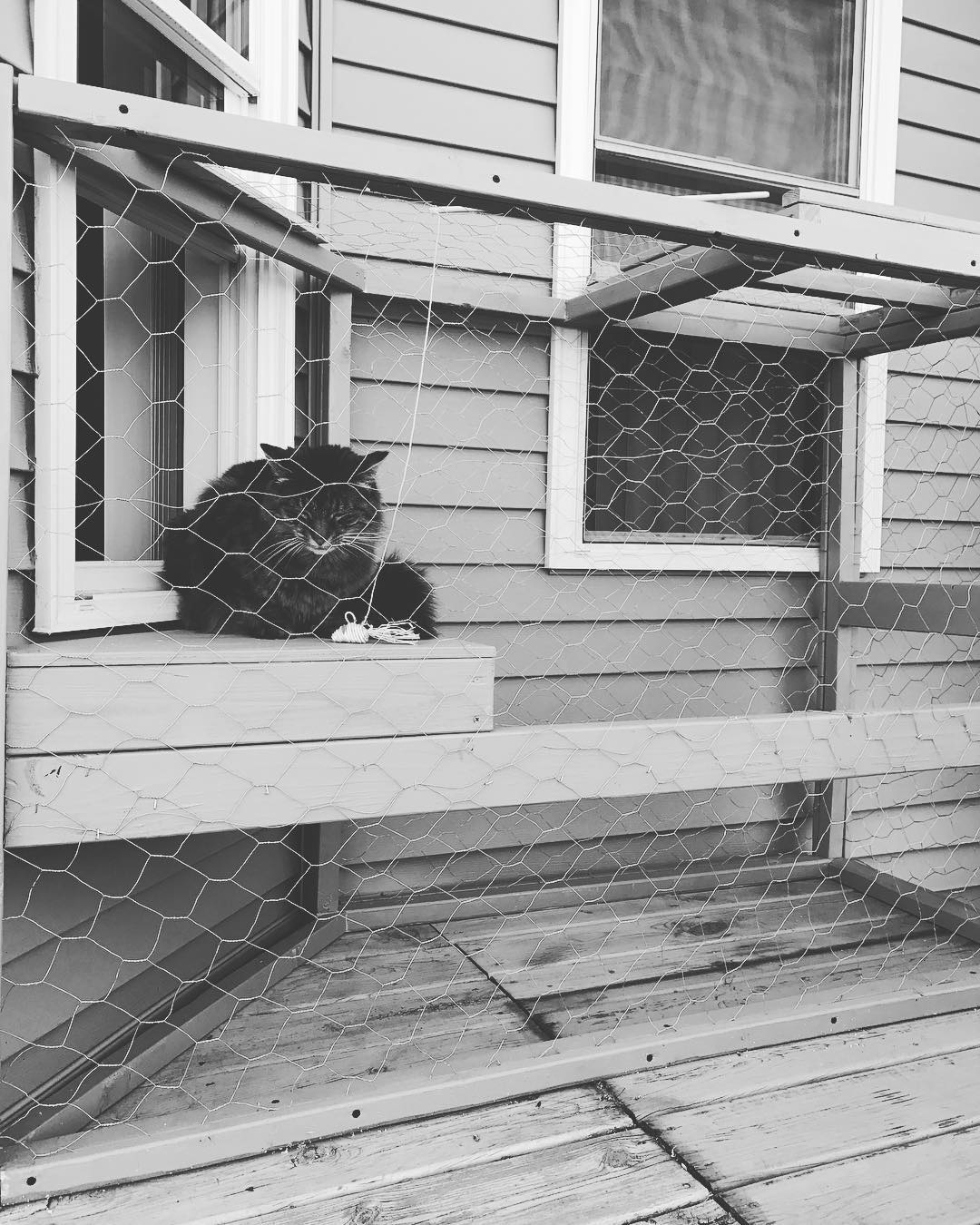
Subi’s catio includes a shelf for easy lounging. (Photo: Nicole Pulfer)
There are many compelling reasons to build a catio, and we’re here to tell you some good news: Building a catio is much easier and less expensive, than you might think. Even if you live in an apartment with nothing but a fire escape, you can make it work. Here’s how.
First, find the right place
Work with the space you’ve got! Pick a window, or even a doggy door, to attach your catio to. If you have a patio, deck or balcony area, even better! You want to give your cat easy access to an outdoor space without blocking your own, so plan strategically.
If you’ve got a patio or deck, that’s an easy go-to.
Some people turn their entire deck into a catio by encasing it in chicken wire and lattice. That’s the setup that James Beaton, cat-dad to Billie and Boo, has.

With some lattice, chicken wire and an adapted Ikea shelf, this easy catio has Billie the cat ‘feline’ good.
(James Beaton)
“Once the enclosure was constructed, I adapted Ikea shelving so that the cats would have platforms to sit on and watch over the back yard,” he said.
For these indoor cats, the catio has made all the difference.
“I’ll sometimes wonder where they are,” Beaton says, “and I go out there and they are stretched out in the sun with the fresh wind blowing all sorts of smells their way.”
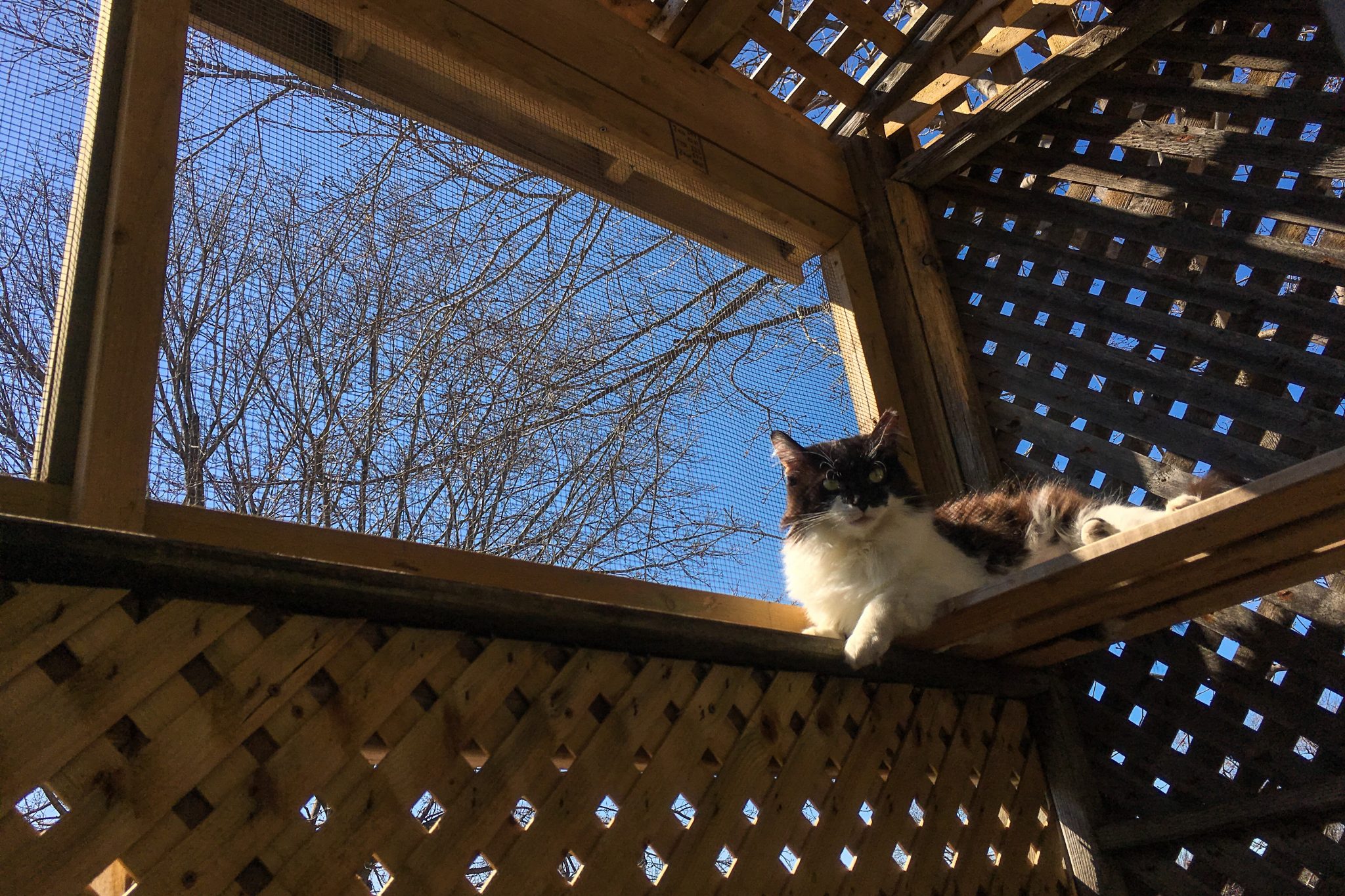
Boo loves to find sunny spots on the shelf installed in his catio. (Photo: James Beaton)
Can’t dedicate an entire deck to your feline roommate?
Susie Peterson and Richard Moore built their catio from their laundry room window onto their covered patio. With a bit of wire screen and lumber, they had a working catio in no time, and it enabled them to share the outdoor space with their cat, Riley.
Moore kindly shared his catio plans with us, which are adaptable for anyone. Download them here.
Next, decide on your materials
“Plan carefully,” Hardiman says. “You’ll save a lot of time and material by figuring out beforehand what you’ll need. Also, research methods ahead of time for securing your wire or trellis for the best possible solution. We ended up using a thin spool of wire to twine the chicken wire to the wood frame. It was really time-consuming, but the staples from the staple gun were just popping out. One last thing would be to plan to have the floor sturdy enough to hold a person. We went with 1/4″ plywood for the floor, and it was really flimsy and totally useless when it came to us trying to stand on it to work.”
Recycling for the win!
“My husband built our catio out of repurposed materials from a chameleon enclosure he built for our son several years ago,” Cynthia Fuller of North East Maryland says. “He used scrap wood and screen that he stapled to the frame. The floor is made out of a pallet that he brought home from work.”
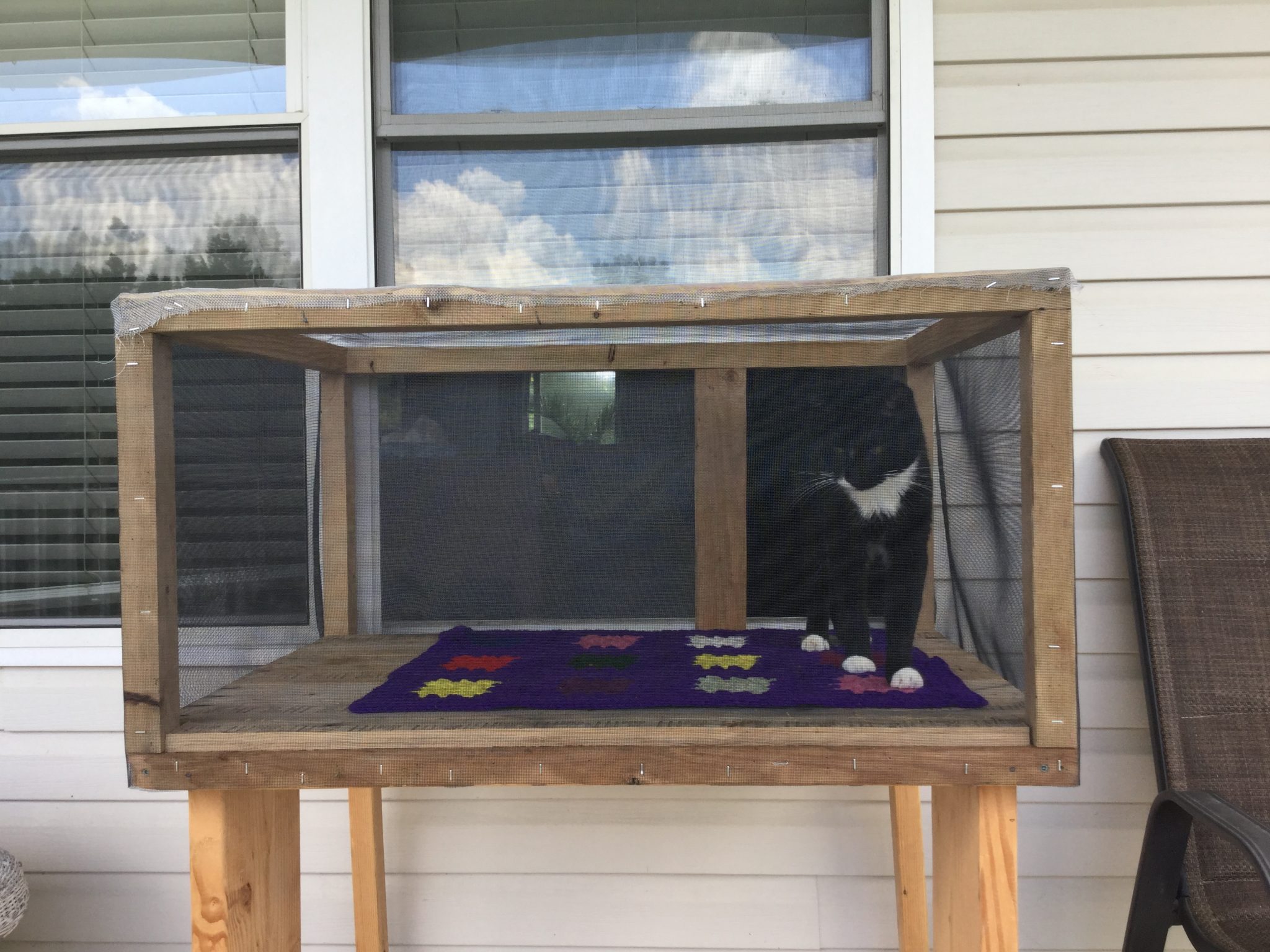
This easy catio sticks right out of a partially-opened window. (Photo: Cynthia Fuller)
Fuller and her husband attached the catio to a living room window under a shady, covered porch. Casper, an indoor cat who she affectionately nicknamed Cat Man, loves his new perch.

Someone found a sun puddle in his catio! (Photo: Cynthia Fuller)
“His reaction to the catio is amazing. He loves it. Mostly mornings, twilight and cool breezy afternoons are his favorite times. Also, when someone pulls in the driveway he runs out to meet them,” Fuller says. “In the morning, he’ll scratch at the blinds for us to open the window.”
The dog crate method: Easy as 1, 2, 3
“Get a large dog crate and two L hooks,” Skylar Pratt of Buffalo, New York, suggested. “Hang the dog crate off the two L hooks that you put in the outside wall of the house or apartment at a height where the bottom of the crate can rest on the windowsill. If there is not enough security, you can add a piece of wood like a 2×4 under the crate and screw that to the wall/crate for added support.”
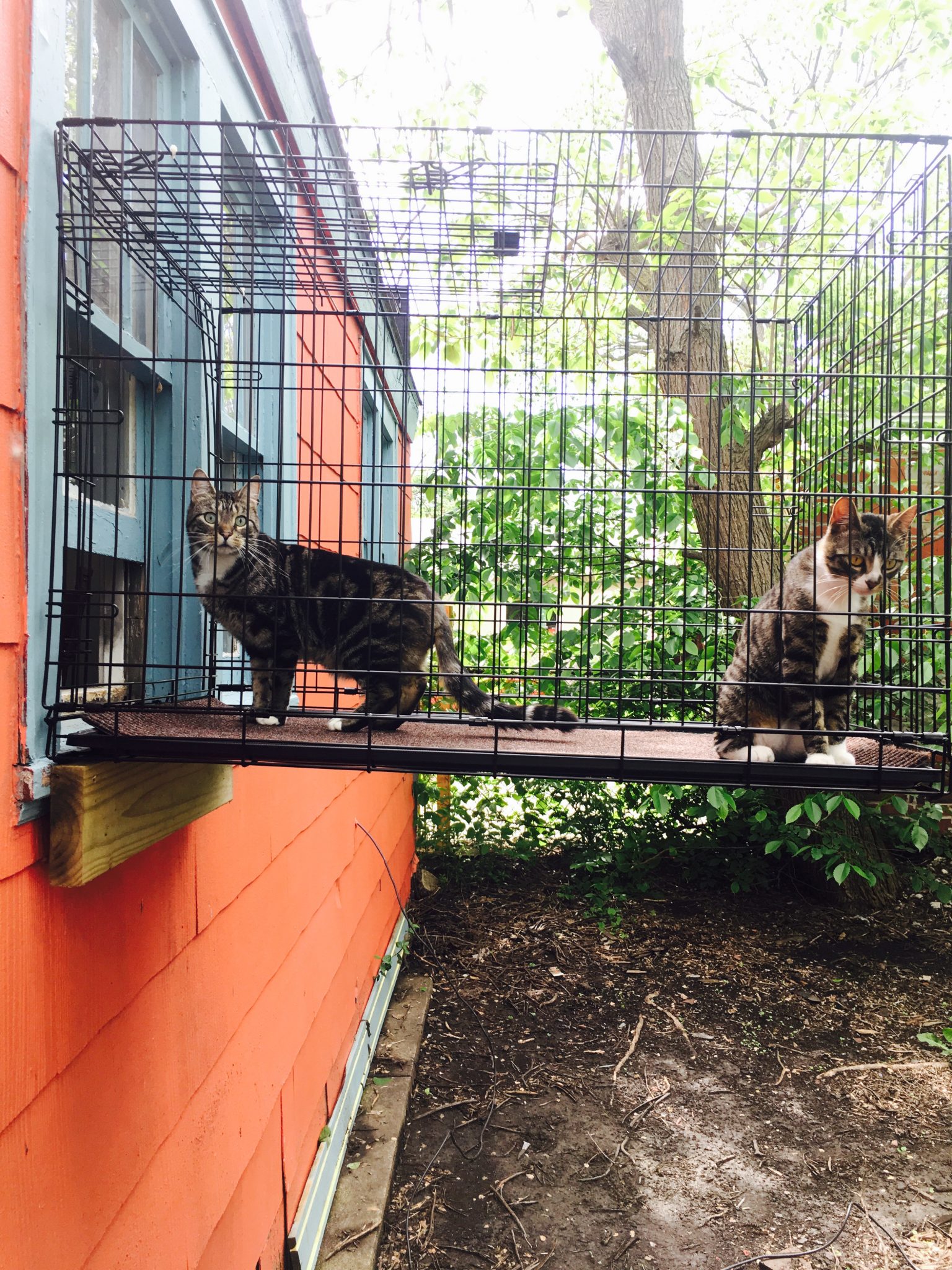
A 2×4 under the crate adds extra support tn this catio. (Photo: Skylar Pratt)
Pratt also recommends drilling holes into the bottom of the dog crate for better drainage when it rains, and an outdoor carpet to make it more comfortable.
Pratt’s two cats were both used to the outdoors until they moved to the city. “I felt horrible not being able to let them enjoy the beautiful weather we so rarely get in Buffalo,” she said.
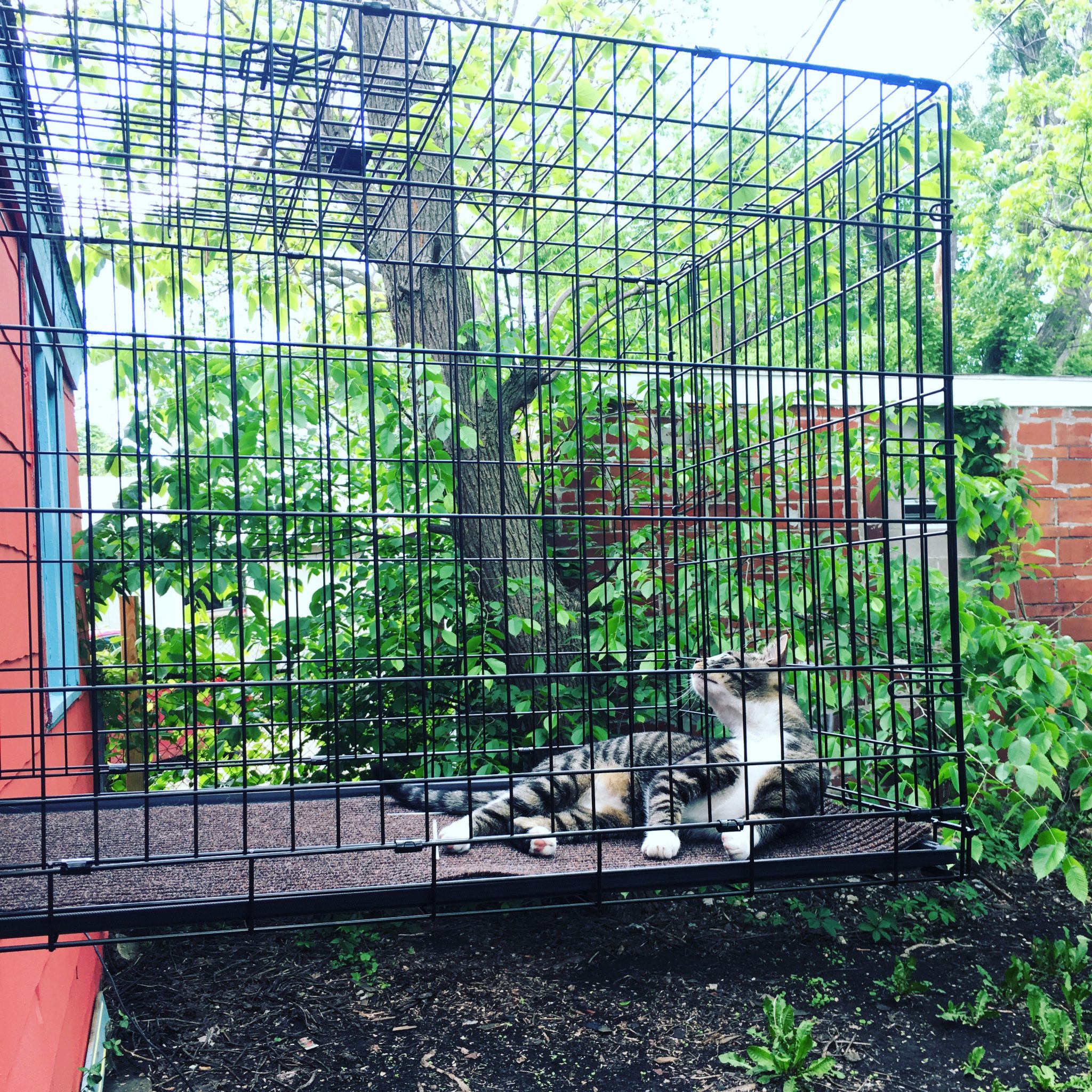
1 large dog crate + 2 L hooks = easy peasy catio! (Photo: Skylar Pratt)
Pratt says she barely finished installing the catio when the kitten started to sunbathe on it.
“They love it, and I don’t feel like I completely took away their freedom anymore,” she said.
Finally, work with the space you’ve got
Remember, if you can’t build out, you can always build up! This is a great option for smaller patios, or areas that you want to share space with the catio.
“We didn’t have a lot of room on our back patio, so we had to make the best use of the space that we had,” Holli Johannes of Portland, Oregon, said. The previous owners of their home had installed a doggy door, so they utilized that to create a catio for their kitty, Walter.
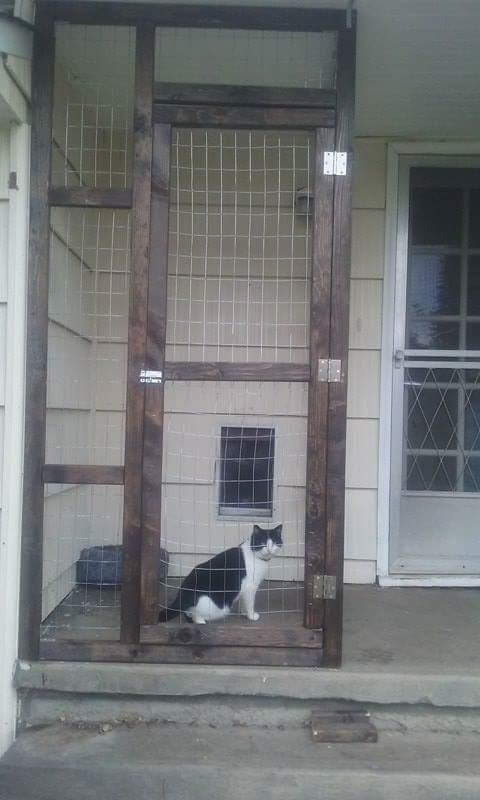
Holli Johannes was able to utilize a pre-existing doggy door to build this catio. (Photo: Holli Johannes)
“The catio extends all the way to the ceiling and has staggered ‘wooden’ shelves covered in outdoor carpeting that are big enough for him to lie on. We covered the outside with wire to keep him contained. We also added a human-size door with a latch so that we can get in there and clean. All told, it cost us less than $100.”
After a bit of training to use the doggy door, Walter soon became the first and only pet to use it – even his canine siblings don’t know how!
An office window will do the trick, too, and you don’t have to be a carpenter to make it work.
Alicia Arciero, a Californian cat mom to indoor cats Georgie and Frankie, says she and her husband spent a single afternoon on their catio and about $200 on materials, which consisted of eight 2x4s, three 1x2s, three 1x4s, two sturdy pressed boards for the shelves and door, a tight chicken wire roll, a screen roll, a sheet of plexiglass, carpet pieces, a box of nails and a staple gun.

Alicia Arciero enclosed the entire space, from top to bottom, in front of a window connected to a patio. (Photo: Alicia Arciero)
They went the extra mile and added shelves for Georgie and Frankie to climb on, plus a plexiglass bottom so the cats can see below them.
“My husband also added a door so I could get in to it to clean,” Arciero said.
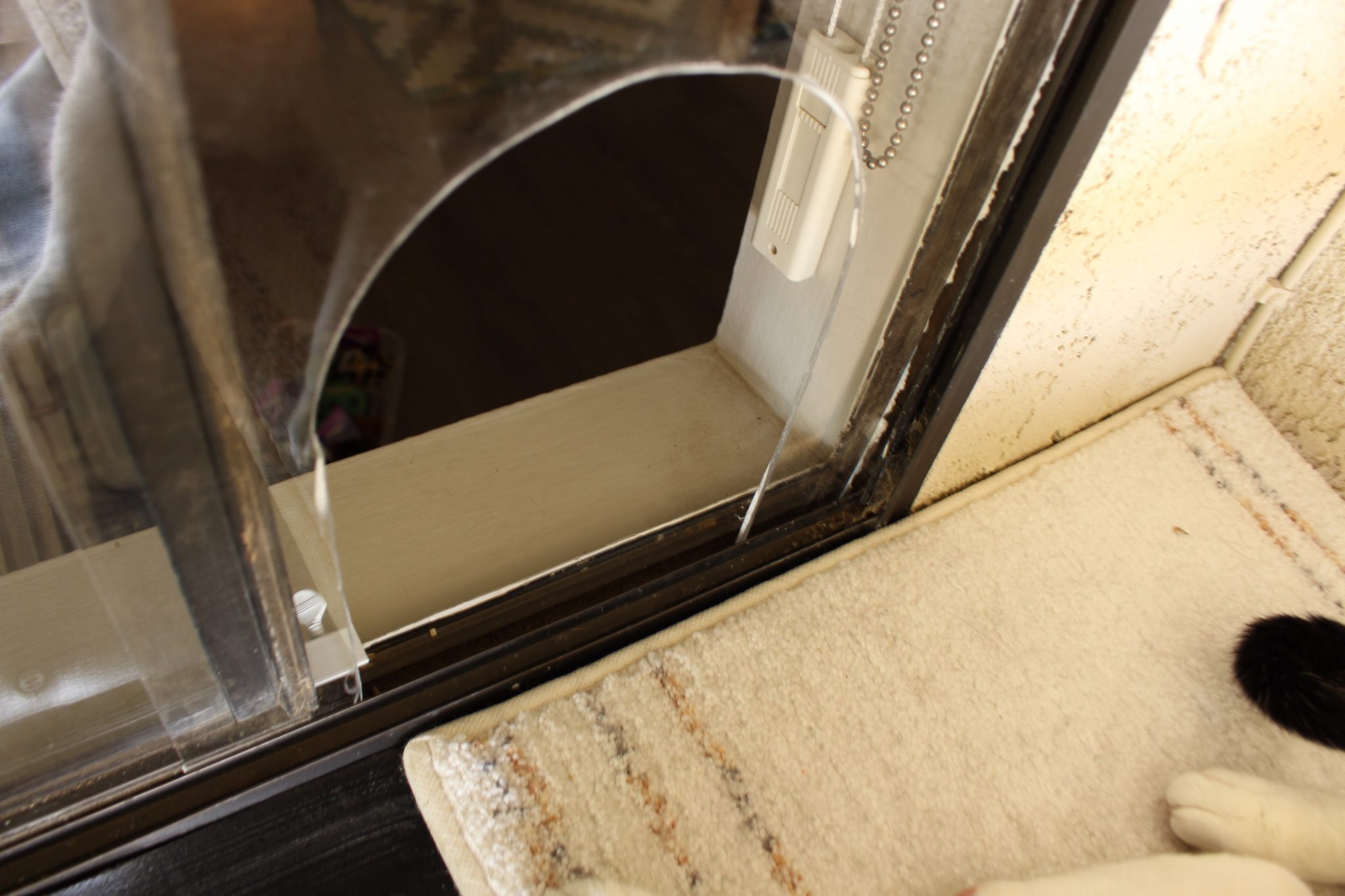
The plexiglass opening makes for an easy ‘cat door’ to Alicia Arciero’s catio. (Photo: Alicia Arciero)
In an apartment with little more than a fire escape? No problem!
Emily Nodine, owner of two beautiful Norwegian forest cats named Mo and Olivia, decided to put her third-floor apartment’s fire escape to good use. She and her husband simply enclosed the space and secured the catio with easily removable zip ties and bungee cords.

Mo and Olivia LOVE their cool catio! (Photo: Emily Nodine)
“We enclosed the sides with chicken wire — that was the easy part, since it didn’t affect the fire escape functionality at all — and then created a door to block off the stairs,” Nodine said. “The door is secured with a bungee cord, and it opens outward, so it can be opened easily in the event of a fire. Finally, we created a roof made of something called ‘pet mesh,’ which is just a rubber mesh material. This is also attached with bungee cords so that we can unhook it and then push it out of the way if we ever needed to use the fire escape.”
Making it an adjustable catio has enabled them to comply with safety codes, and now it’s portable for their next move.
“Finally, we installed an insulated panel with a cat door in the window where the access to the catio is,” Nodine explained. “This allows us to keep the space open year-round, as opposed to having to close it when it gets too cold to leave the window open.”

Mo and Olivia get a great view of the birds in the trees on their fire escape catio. (Photo: Emily Nodine)
Now Mo and Olivia are obsessed.
“It’s up high in the trees, so they have a great view of all the birds and squirrels that are running around up there,” Nodine said. “And they can watch people walking by on the street down below.
They’re also living up to their Norwegian name. “The girls even love to be on the catio in the winter! The cold doesn’t seem to bother them at all; they love to go out when it’s snowing to watch the snow fall and play in it and leave little kitty footprints everywhere.”
Turn your catio in to a purradise
Once you’ve built your catio, the possibilities abound. Adding shelves can give cats a place to play, climb and nap.

The plexiglass strip at the bottom of Alicia Arciero’s catio allows the cats to see out, and her to see in. (Photo: Alicia Arciero)
“I used fishing line to hang some toys and put a scratching post on the bottom,” Arciero said.
You might also consider sprucing up your catio with some cat-friendly plants like cat thyme, valerian or even catnip. (We’re sure your cats would appreciate it).
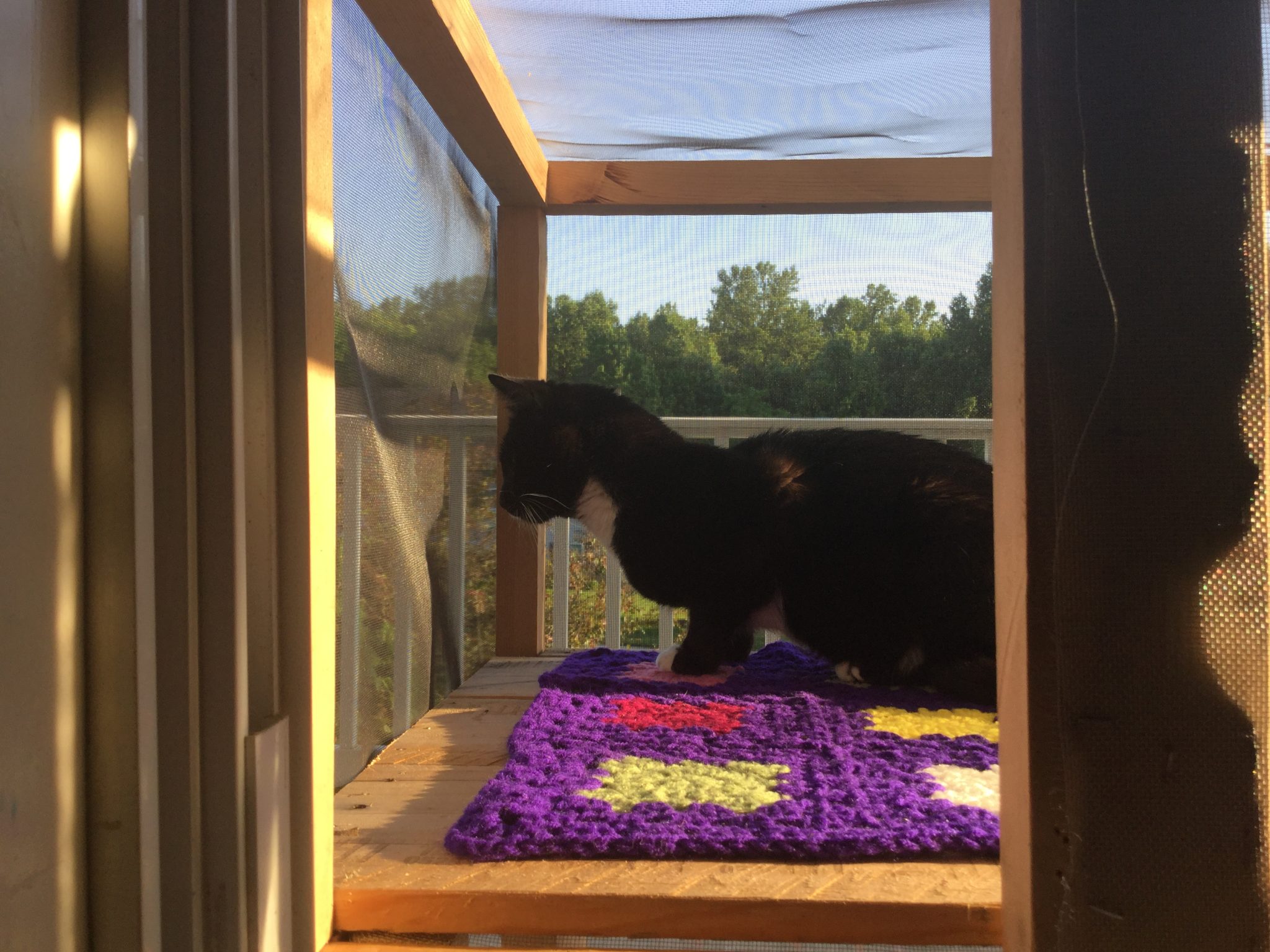
With his handmade blanket, Casper has quite the setup for a sunny morning. (Photo: Cynthia Fuller)
Pillows, beds, homemade blankets and even cat hammocks add to the snuggly feel and encourage cats to spend more time outdoors.
And all cat owners know that something as simple as a cardboard box could become a cat’s new favorite thing.
Our best advice? Go for it!
Whether you’re spending an hour, an afternoon or an entire summer creating the purrfect catio for your cat, rest assured your efforts will be rewarded.
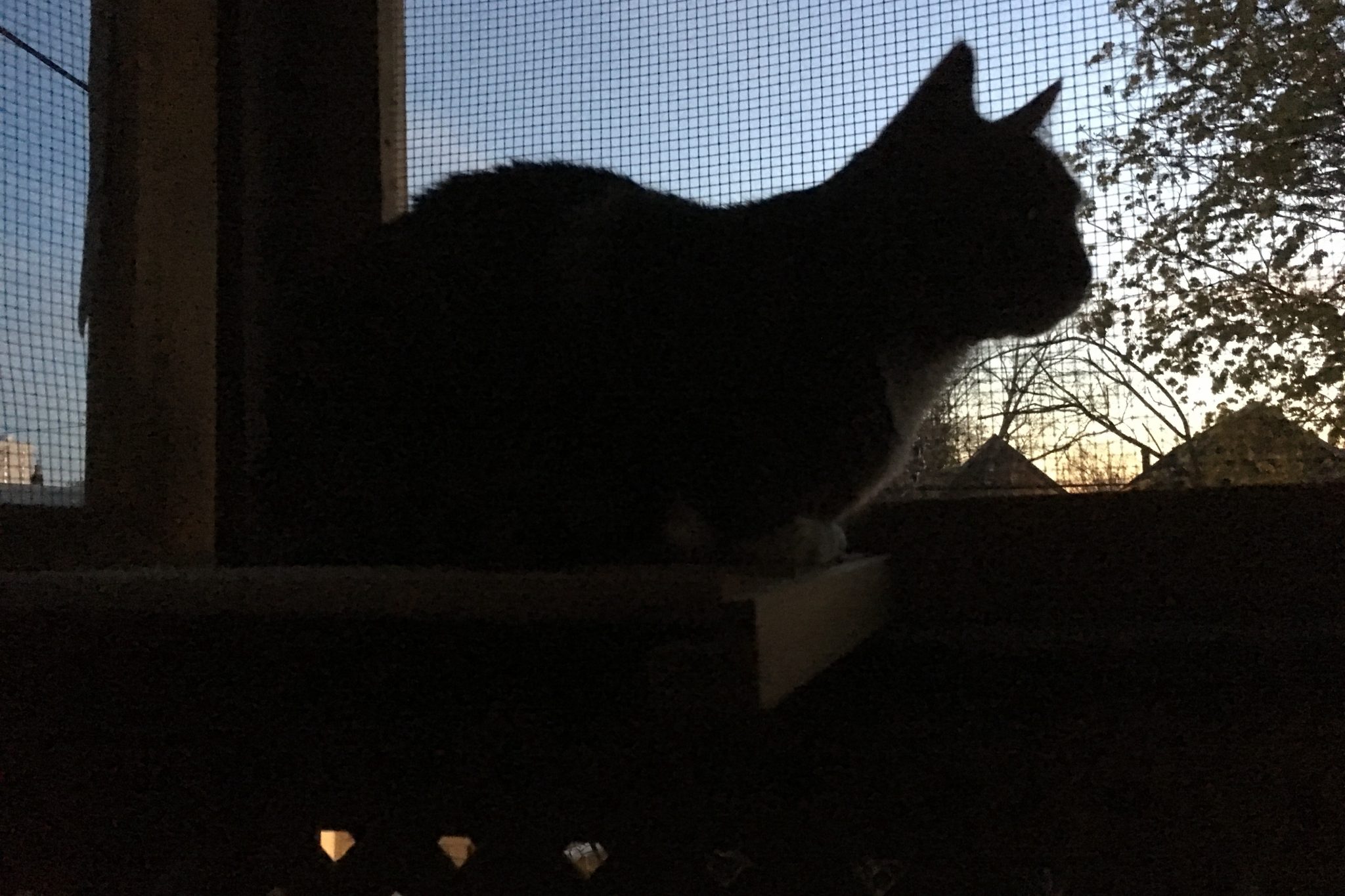
There’s nothing quite like a catio sunset. (Photo: James Beaton)
“Most cats are very resilient, intelligent and naturally curious,” Arciero said. “This is perfect for new unknown areas such as a catio. It is built into their nose to explore and investigate and ultimately learn that area is an extension to their home.”
Hers were no exception, even though they had always been indoor cats.
“They were both eagerly waiting at the window, pretty much all day while the build was occurring. They went in right away, checked it out, rubbed all over it and took a nap,” Arciero says. “It was the best thing to see.”
[separator type=”thin”]
Scroll through the gallery at the top for more “inspurrational” catio photos, and for additional information on constructing a catio, we recommend this article from the Humane Society.




